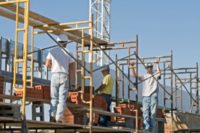 A study being used by the construction industry to support a bid to change New York’s century-old Scaffold Law is tainted, according to opponents of the revisions, who say it was heavily edited by the business interests who funded it.
A study being used by the construction industry to support a bid to change New York’s century-old Scaffold Law is tainted, according to opponents of the revisions, who say it was heavily edited by the business interests who funded it.
Charlene Obernauer, Executive Director of the New York Committee for Occupational Safety and Health, says the study by by SUNY’s Nelson A. Rockefeller Institute of Government was influenced by numerous comments and edits sent to the researchers throughout the process.
Study funders were actively involved in study
The Institute denied those claims in a statement issued in April: “The funder did not attempt to influence the development of the research design, collection or analysis of data at any time during the study.”
Nonetheless, documents released because of Freedom of Information Act (FOIA) requests yield evidence to support the Scaffold Law supporters’ tampering claims. Among the emailed suggestions and comments sent by Tom Stebbins of the Lawsuit Reform Alliance of New York to the researchers were two pages of comments, some of which appeared to be aimed at influencing the study’s conclusion which was – ultimately – that the Scaffold Law “blunts employers’ incentives to invest in worker safety.”
Institute refuses FOIA request for final draft
The Institute’s refusal release the final draft of its research – in spite of FOIA requests for it – makes it impossible to determine whether or not Stebbins’ suggestions influenced the outcome of the study.
FOIA requests were filed by both sides after the Institute admitted that a section of the study was flawed and had been released to the study’s funders prematurely. The section in question was a statistical analysis showing that construction injuries in Illinois decreased after that state changed its scaffold law.
Employer v. employee responsibility for accidents
At the center of the controversy is New York’s longstanding Scaffold Law, which holds employers responsible for elevated-related workplace injuries. Opponents say the law drives up construction costs. They are pushing for a “comparative negligence” standard that would assign some of the responsible to workers whose actions contribute to an accident.
“The Scaffold Law remains a critical worker safety protection for people doing dangerous construction work, particularly Latino and immigrant workers without union protection,” wrote Obernauer in an op-ed piece in timesunion.com. Obernauer said the law has “made New York construction sites among the nation’s safest by providing a powerful incentive for property owners and general contractors to follow the law and keep workers safe.”
However, the Lawsuit Reform Alliance points out that New York is the only state the the U.S. to hold contractors and property owners absolutely liable for any elevation related injuries sustained by a worker, regardless of the worker’s own negligence.
The Alliance said switching to a comparative liability standard would “stimulate job creation, improve workplace safety and reduce the burden on the state and its taxpayers.”


